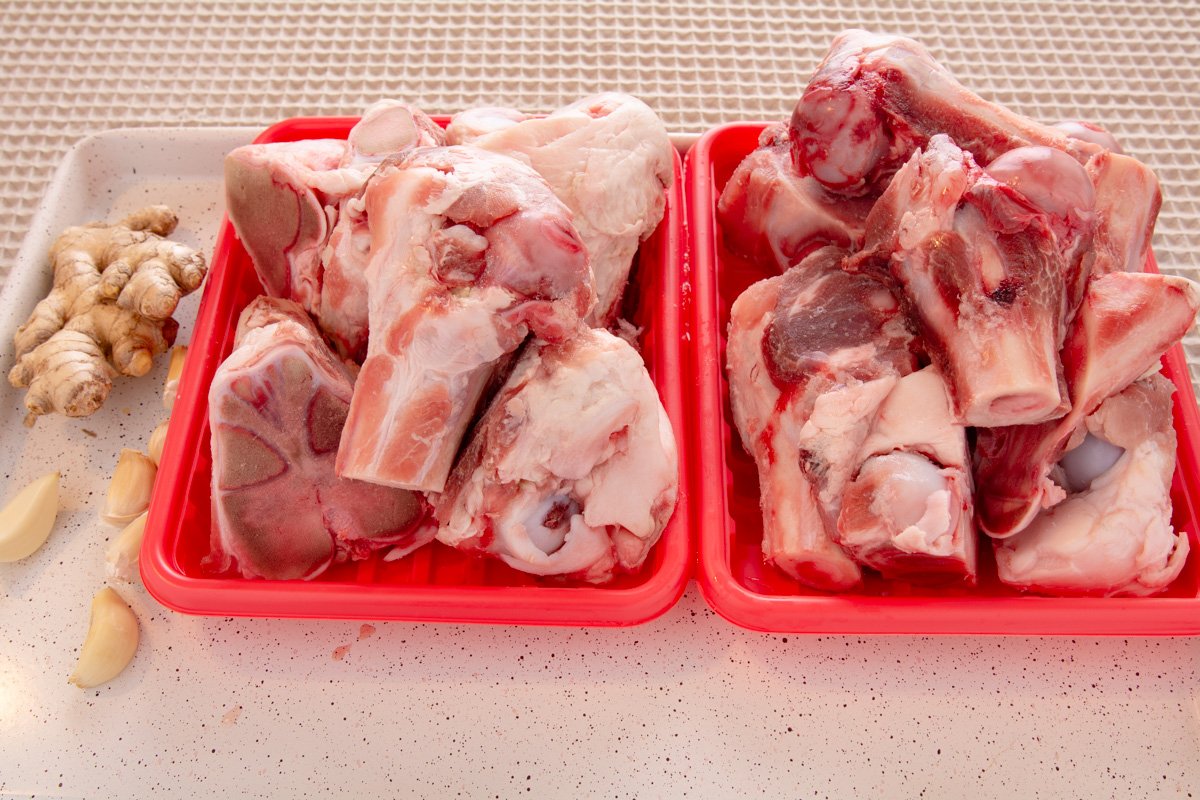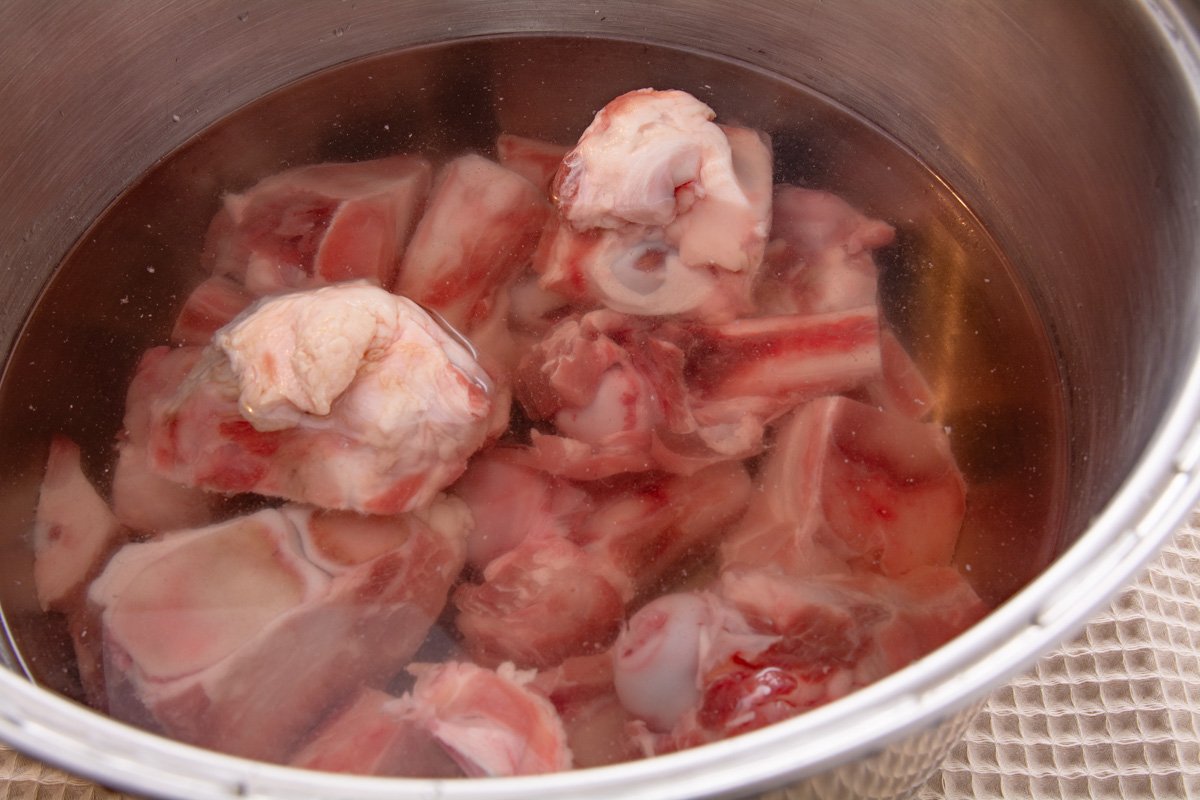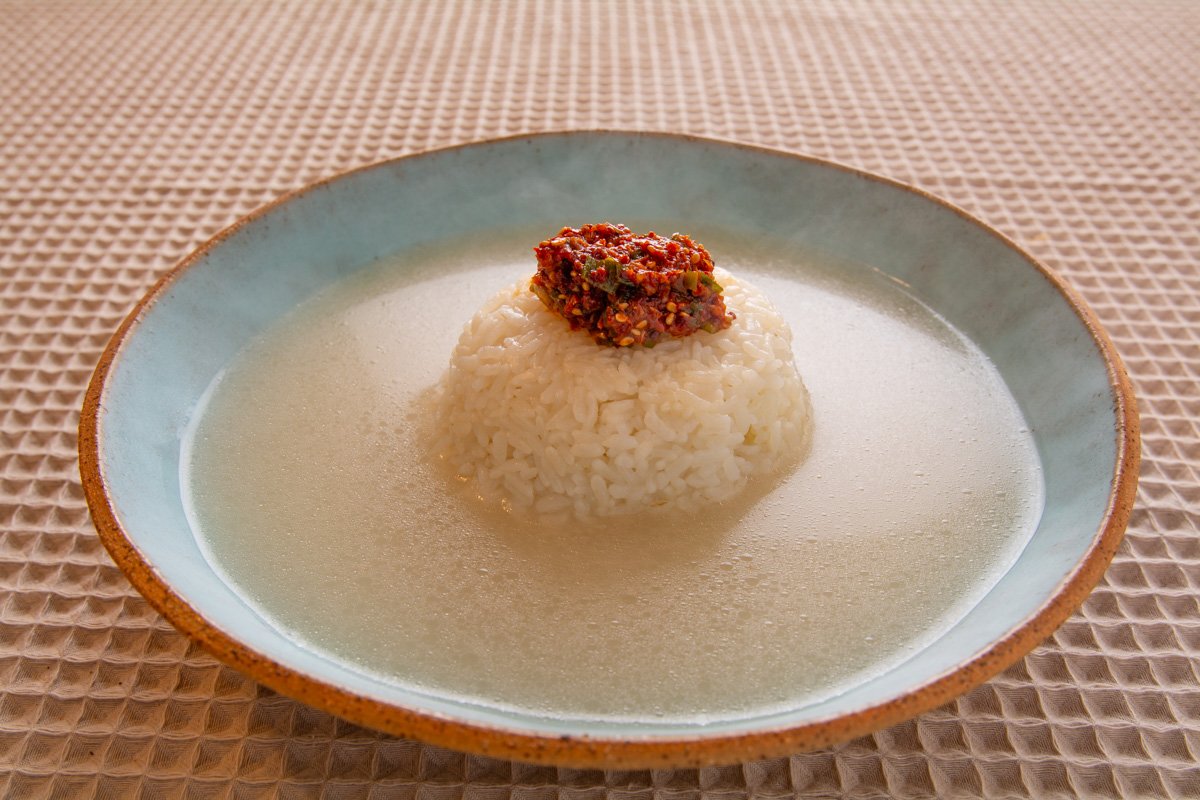When I first visited Busan, South Korea, I had the pleasure of being introduced to Daeji Gukbap (돼지국밥), also known as Pork Rice Soup. In Busan, this dish is a beloved local favorite. It’s a heartwarming and comforting soup crafted from pork bones, and its secret lies in the slow simmering process, which results in a broth bursting with flavor.
Traditionally, Daeji Gukbap is served with rice, and you have the freedom to customize its taste with various condiments and seasonings, such as gochujang (red chili paste) and salted shrimp. This adaptability allows you to tailor the soup to your personal preference.
Daeji Gukbap is not just a dish; it’s a warm embrace during chilly weather, cherished as a quintessential Korean comfort food.

Ingredients
Pork bones are rich in collagen and marrow, which, when simmered over an extended period, infuse the broth with a deep, savory flavor. This results in a robust and satisfying taste that characterizes Daeji Gukbap.
The collagen in pork bones also contributes to the soup’s slightly thickened texture, giving it a satisfying and comforting quality
Ginger is known for its digestive properties, which can help with digestion and provide relief from any potential heaviness associated with consuming rich, fatty pork broth.
Garlic is a commonly used ingredient in Korean cuisine, and its presence in Daeji Gukbap is part of the traditional and cultural heritage of the dish.
Onions contribute a pleasant and appetizing aroma to the dish. Their fragrance, when sautéed or simmered, enhances the sensory experience of the soup. I did not use onions in this batch of soup but usually I do.
Let’s embark on creating a deliciously clean bone soup

Start by placing your pork bones in a stockpot and covering them with water. Let them soak for approximately an hour. Afterward, carefully drain the water, ensuring a thorough wash, especially around the cut edges to remove any bone fragments. This step ensures a pristine base for your soup.
Once your bones have soaked and been rinsed, it’s time to move on to blanching. This essential step eliminates any potential off flavors, resulting in a beautifully clean-tasting soup.
To blanch the bones, add them to a large pot and cover them with enough water. Cover the pot, turn up the heat, and bring it to a boil. Then, reduce the heat to maintain a gentle, slow boil for 25 to 30 minutes.

After this process, place the bones in a colander and dispose of the liquid. Give your stockpot a good cleaning and rinse the bones to ensure any remaining scum is removed.

I enjoy serving my soup with some tender, boiled pork. It’s a delightful addition to the broth, and here’s how I prepare it:
I cook the pork in the same manner as the bones, creating a harmonious blend of flavors. Typically, I simmer the meat and bones together until the pork reaches a perfect tenderness. My go-to choices for the meat include Boston butt or country-style ribs, both of which have just the right amount of fat to infuse the soup with flavor. If you’re feeling indulgent, pork belly is another fantastic option that adds an extra layer of richness to the dish. So, choose your favorite, and let the flavors meld in this comforting soup.

If needed, skim off any fat that rises to the top during the simmering process.
Finally, return the cleaned bones (and any meat if you like) to the stockpot. Cover everything with water, bring it to a slow boil, and let it simmer for 8 to 12 hours. This long, slow simmer extracts all the wonderful flavors from the bones.
Once your bone broth has reached its full potential, strain it to remove any lingering bits of fat, bone, meat, and vegetables, leaving you with a clean and delightful base for your soup.
How to serve daeji gukbap
Serving Daeji Gukbap, a delicious Korean pork bone rice soup, involves presenting it traditionally and providing a variety of condiments and sides for customization. Here’s how to serve Daeji Gukbap:
1. Main Dish:
- Daeji Gukbap itself is the star of the meal. Serve it in a deep bowl, ensuring you include a generous portion of the flavorful broth, tender pork, and rice.
2. Condiments:
- Offer an array of condiments to allow diners to customize the flavor of their Daeji Gukbap to their liking. Common condiments include:
- Gochujang: A red chili paste that adds a spicy kick.
- Salted Shrimp Sauce: Adds a savory and slightly briny flavor.
- Sliced Green Onions: Fresh and crunchy, these add a burst of flavor and texture.
- Soy Sauce: For those who prefer a milder, salty seasoning.
3. Side Dishes (Banchan):
- Complement Daeji Gukbap with traditional Korean side dishes, known as banchan. Common options include kimchi, pickled vegetables, and seaweed. These sides add variety and balance to the meal.
4. Fresh Vegetables:
- Serve fresh vegetable sides like lettuce leaves, perilla leaves, or sliced cucumbers. These can be used to wrap bites of Daeji Gukbap, adding freshness and crunch.
5. Aromatics:
- Provide additional aromatics such as minced garlic and sliced green chilies for those who enjoy an extra flavor punch.
6. Warm Rice:
- Daeji Gukbap traditionally includes rice, but some diners may prefer extra rice on the side. Have steamed rice ready for those who want to add more to their bowl.
7. Table Settings:
- Set the table with individual bowls, chopsticks, and spoons. Diners can use chopsticks to pick up solid ingredients and a spoon for sipping the broth.
8. Serving:
- Daeji Gukbap is often enjoyed family-style, with the main pot of soup placed in the center of the table and diners serving themselves. However, you can also pre-portion the soup into individual bowls before serving.
9. Enjoy:
- Encourage diners to mix and match condiments, sides, and vegetables to create their own unique Daeji Gukbap experience. Enjoy the warm, comforting flavors of this Korean classic!
By presenting Daeji Gukbap with these accompaniments, you create an immersive dining experience where everyone can tailor their soup to their preferred taste and enjoy the rich, savory flavors of this beloved Korean dish.
Seasoned Gochujang Paste
Prepare your own Gochujang Seasoning with just a few simple ingredients:
- 2 TBS Gochujang
- 1 teaspoon Doenjang
- 1/2 TBS Salted shrimp
- 1/2 TBS Crushed
- 1/4 tsp White pepper
- 2 TBS Green onion
Mix these components in a small bowl, and voilà! It’s ready to elevate the flavors of your soup, meat, and more.
If you found this recipe delightful, you might want to give my Korean Oxtail Soup Recipe a try. It’s prepared in a very similar manner and promises another delicious journey into Korean flavors. Happy cooking!


Ingredients
- 7.5 pounds Pork Bones
- 2 oz Ginger
- 5 Cloves Garlic
- 3 Gallons Water
Instructions
- Start by adding your pork bones to a stockpot and covering them with water. Let them soak for about an hour, and then carefully drain the water. Be sure to wash the bones thoroughly, paying extra attention to where they were cut. This step ensures all bone fragments are removed.7.5 pounds Pork Bones
- Once your bones are clean, return them to the stockpot along with ginger and garlic. Cover everything with water and place the pot over high heat. Bring it to a boil, and then reduce the heat to maintain a slow, gentle boil for 25 to 30 minutes.2 oz Ginger, 5 Cloves Garlic
- Afterward, place the bones in a colander and discard all the liquid. Give your stockpot a good cleaning and rinse the bones to remove any remaining scum.
- As needed, skim off any fat that rises to the top.
- Finally, return the cleaned bones and any meat to the stockpot, covering them with water. Bring everything to a slow boil and let it simmer for 8 to 12 hours.
- When your bone broth is ready, strain it to remove any remaining bits of fat, bone, meat, and vegetables.